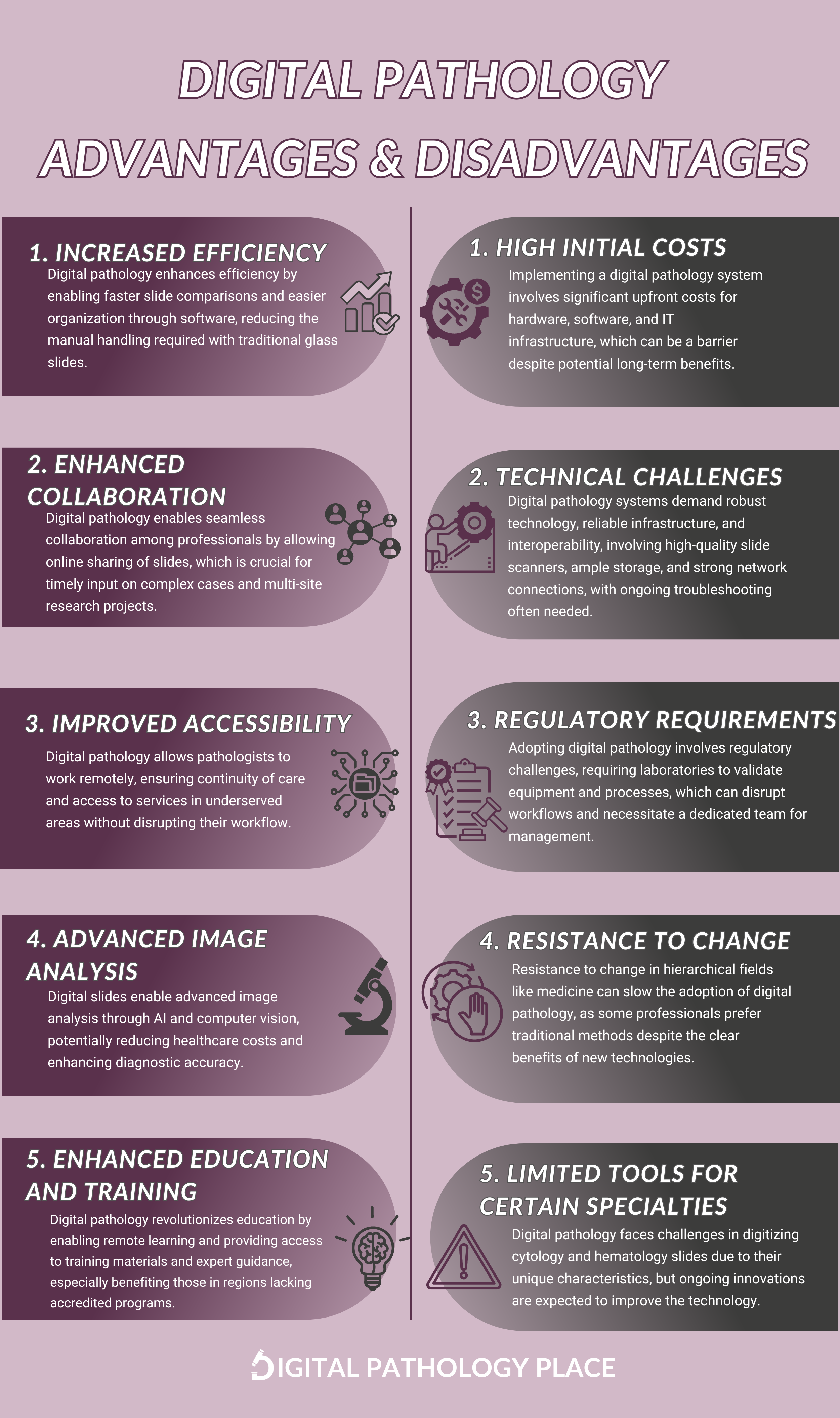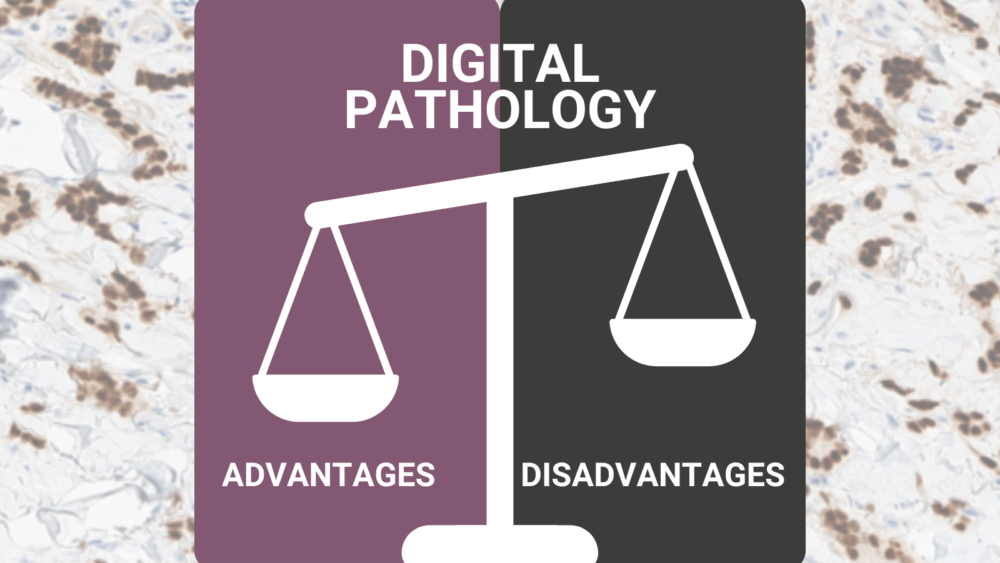Exploring the Advantages and Disadvantages of Digital Pathology
Advantages of Digital Pathology
1. Increased Efficiency
One of the most notable benefits of digital pathology is the significant increase in efficiency it brings to pathologists’ daily work:
-
- Streamlined Workflow: Gone are the days of cluttered desks piled high with glass slides. No need to manually take the relevant slides from the maps to maintain evaluation consistency. Digital pathology allows for quick maneuvering and easy organization of slides through software.
- Faster Comparisons: Pathologists can quickly compare multiple slides side by side, enhancing diagnostic accuracy, scoring consistency, and speed.
- Improved Organization: Digital image management systems enable better tracking and management of cases, reducing the risk of lost or misplaced slides.
- Cleaner Workspace: With digital slides, pathologists can maintain a more organized and clutter-free work environment. Sound like a nice-to-have? Actually, clean desks and work spaces translate into increased accuracy.
2. Enhanced Collaboration
Digital pathology breaks down geographical barriers, facilitating easier collaboration among professionals:
- Instant Sharing: Digital slides can be shared online instantly, enabling quick consultations and second opinions. This counts both for static images as well as whole slide images.
- Multi-Site Studies: Researchers can easily collaborate on projects across different institutions or countries.
- Complex Case Management: Difficult cases benefit from immediate input from multiple experts, improving diagnostic accuracy.
- Interdisciplinary Cooperation: Digital pathology allows for easier sharing of information between pathologists and other medical specialists.
3. Improved Accessibility
The remote access capabilities of digital pathology have far-reaching implications:
- Serving Underserved Areas: Pathologists can provide services to remote or underserved regions without being physically present.
- Work Continuity: Professionals can maintain their workflow even when traveling or working from different locations.
- 24/7 Access: Digital slides can be accessed at any time, facilitating flexible working hours and urgent case reviews.
Disaster Recovery: Digital archives ensure that valuable pathological data is protected and accessible even in the event of physical damage to a laboratory.
4. Advanced Image Analysis
The digitization of pathology slides opens up exciting possibilities in image analysis:
- AI and Computer Vision: Leveraging artificial intelligence and computer vision algorithms can reveal insights from pathology images that were previously difficult to discover.
- Quantitative Analysis: Digital tools enable more precise measurements and quantification of pathological features.
- Predictive Modeling: Some AI models can predict molecular properties directly from tissue images, potentially reducing the need for additional tests.
Standardization: Digital analysis can help standardize diagnostic criteria across different institutions and regions.
5. Enhanced Education and Training
Digital pathology is revolutionizing pathology education and training:
- Remote Learning: Students and professionals can access training materials and expert guidance from anywhere in the world.
- Standardized Resources: Digital slide libraries ensure all students have access to the same high-quality educational materials.
- Interactive Learning: Digital platforms allow for more interactive and engaging educational experiences.
Continuous Professional Development: Pathologists can easily access a wide range of cases for ongoing learning and skill improvement.

The Challenges of Digital Pathology
1. High Initial Costs
Implementing a digital pathology system requires significant upfront investment:
- Hardware: High-quality scanners and workstations are essential but still expensive.
- Software: Image management systems and analysis tools often come with substantial licensing fees.
- IT Infrastructure: Robust networks and storage systems are necessary to handle large amounts of data.
Integration: Costs associated with integrating digital pathology into existing hospital or laboratory systems can be significant.
2. Technical Challenges
Adopting digital pathology comes with its share of technical hurdles:
- Scanner Quality: Ensuring consistent, high-quality scans is crucial but can be technically challenging.
- Storage Requirements: Digital slides require substantial storage capacity, which can be costly and complex to manage.
- Network Reliability: A robust and reliable network is essential for the smooth operation of digital pathology systems.
Interoperability: Ensuring different components of the digital pathology ecosystem work together seamlessly can be complex and requires ongoing good relationships with multiple vendors.
3. Regulatory Requirements
The transition to digital pathology involves navigating complex regulatory landscapes:
- Validation: All equipment and software must be validated to ensure accuracy and reliability.
- Compliance: Systems must meet Good Laboratory Practice (GLP) standards and other regulatory requirements.
- FDA Oversight: Potential FDA regulation of laboratory-developed tests may impact digital pathology adoption.
Data Security: Ensuring the security and privacy of digital pathology data is crucial and must meet strict regulatory standards.
4. Resistance to Change
Perhaps the most significant barrier to widespread adoption is the human factor:
- Comfort with Traditional Methods: Some pathologists may prefer the familiar process of working with glass slides.
- Learning Curve: Adapting to new digital systems requires time and effort, which can be challenging for busy professionals.
- Hierarchical Structures: In the hierarchical field of medicine, introducing new technologies can face resistance from established practitioners.
Workflow Disruption: Implementing digital pathology initially disrupts established workflows, which can be met with resistance.
5. Limitations for Certain Subspecialties
While digital pathology excels in many areas, some subspecialties face unique challenges:
- Cytology: Non-flat specimens in cytology can be difficult to scan accurately.
- Hematology: Blood smears and other hematology specimens present challenges for current scanning technologies.
- Frozen Sections: The rapid turnaround required for frozen sections can be challenging in a digital workflow.
Limited Tools: Some specialized areas of pathology have fewer digital tools available (e.g., when the use of polarized light is required on demand), though this is improving with ongoing innovation.
Watch the full discussion here
Digital pathology represents a significant leap forward in diagnostic medicine, offering improved efficiency, collaboration, and analytical capabilities. It has the potential to transform pathology education, increase access to expert opinions, and drive innovations in image analysis and AI-assisted diagnostics.
However, it also comes with challenges related to costs, technical implementation, regulatory compliance, and resistance to change. As technology continues to evolve, addressing these challenges will be crucial to realizing the full potential of digital pathology.
For those interested in learning more about this exciting field, I recommend exploring resources like the “Digital Pathology 101” book, available as a free PDF or in print. This comprehensive guide offers an in-depth look at the technology and its applications.
As we move forward, it’s clear that digital pathology will play an increasingly important role in healthcare. By understanding both its advantages and disadvantages, we can work together to harness its benefits while effectively navigating its challenges. The future of pathology is digital, and it’s an exciting time to be part of this transformation in medical diagnostics and research.
Related Contents
- VIVA LAS VEGAS I CAP2024
- DIGITAL PATHOLOGY APPLICATIONS: From Clinical Practice to Drug Development
- The two most common mistakes in statistical analysis of pathology studies and how to avoid them
- Introduction to multiplex for tissue image analysis (part 1) w/ Regan Baird, Visiopharm
- Digital Pathology Applications: From Clinical Practice to Drug Development















Comments are closed.